That’s what they’re for, right? They’re snow bikes, buy one and ride in the snow…OK?
Well, not so fast.
First off – BORING ALERT.
Anyone who has ridden in snow will find this redundant – you’ve already discovered what I’m about to reveal. But there’s a few people stumbling out of the woods and finding this blog, (when searching for ‘fat bike’ related terms) so this is for you.
1 – There are Many Different Types of Snow
A year ago had you asked me to describe snow I would’ve said it’s cold and white and gets in the top of your slippers when you’re taking the garbage out to the pavement. But it turns out that there’s a lot more to snow than meets the eye.
So let me cut to the chase and offer up some typical sets of riding conditions along with some notes on what to expect from your fat tire bike. I’ll also cover some tips on tire pressures and compare two different tires.
It’s early winter, temps are getting cool – bobbing in and around the 33-35F range, I can feel snow in the air but it hasn’t landed yet. Riding the trails I’m seeing the dirt and mud go from loose and sloppy to firm and rutted. I’ve dropped a couple psi to help ride comfort but I’m still around the 10psi range and still riding the Vee Rubber all-season tires.
Then, I wake up one late November morning to find a layer of snow on the ground. Yip fricken’ ee it has finally arrived, now I can see what this fat tire bike is really all about.
Hitting the same trails I’ve been riding for the past month, but now with a half inch of fresh snow covering the hard dirt, well there really isn’t a whole lot of difference in how the ride feels. Traction is still good but I do slip out a little on climbs and I feel the front end start to washout occasionally.
Pedaling effort is largely unchanged, the snow isn’t deep enough to cause any significant additional rolling resistance.
Stage #2
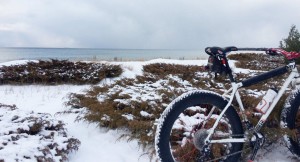 A couple days later the light dusting of snow has been compacted by other trail users. It has thawed a little and re-frozen a couple times. Now, there are dangerous patches of ice on the ground and I’ve had a couple bad spills. The hills are harder to find traction on as the surface is far more slippery.
A couple days later the light dusting of snow has been compacted by other trail users. It has thawed a little and re-frozen a couple times. Now, there are dangerous patches of ice on the ground and I’ve had a couple bad spills. The hills are harder to find traction on as the surface is far more slippery.
It’s time to look at some tires which are more suited to snow.
So I order up a set of On-One Floaters (Links to Review). The On-One tires are not really snow-specific but they have deeper and more widely spaced knobs and they have knobs on the sides of the tire to help cornering in the sloppy stuff (mud or snow). They look a lot like the venerable Surly Nate (in terms of tread profile) but at a much lower cost.
Meanwhile, awaiting delivery of the new tires, we get the usual early winter thaw/freeze cycles and another half inch or so of snow. We also get some light drifting and I get a flavor of what to expect when the snow gets up to the rims.
The new tires arrive and provide very noticeable benefits. They feel more sure-footed on corners, provide better traction on hills and just provide more of a confidence factor. They’re also very noisy on dry surfaces (asphalt) and have a higher rolling resistance in the snow, due to their additional grip. I start to feel my muscles more on my regular short, 90 minute rides.
For the next few weeks nothing much changes. It still isn’t bitter cold, temps remaining in the high 20’s through high 30’s.
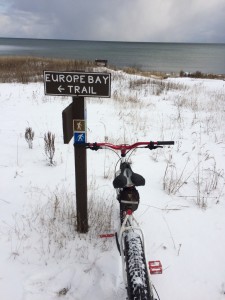 Pretty much everything that’s come along is very manageable for the fat bike during this period. Riding is fun. It’s what I wanted and expected from the bike. I’ve hit several local Park trails and it’s always a blast. I can’t foresee anything changing and I expect this to continue throughout the winter season. Wrong.
Pretty much everything that’s come along is very manageable for the fat bike during this period. Riding is fun. It’s what I wanted and expected from the bike. I’ve hit several local Park trails and it’s always a blast. I can’t foresee anything changing and I expect this to continue throughout the winter season. Wrong.
Stage #3
Wind forward a few weeks and it’s early January. It’s deep winter now, temps are consistently well below freezing, though snowfall is intermittent and quite light, we haven’t really seen much accumulation. A half inch here, an inch there – with sufficient interval between snowfall to allow for some packing-down. No problemo.
Then, we get hit overnight with 5-6″ of that light powdery stuff that comes down when temps are in the single digits to low teens. Suddenly, everything changes.
To highlight the problems, here’s a ride report from Friday 9th January at Peninsula State Park in Fish Creek WI.
I know the park trails here pretty well as I’ve been riding them for about a year now.
The plan is to ride the Sunset Loop, 9.8 miles of easy MUP that accommodates people of all ages during the summer months.
Then, after the 9.8 mile loop, I plan to do as I always do and go ‘deep-woods’ for the gnarly single track.
 The first stretch of trail out from the Ranger’s office and parking lot is usually pretty well packed down, but not today. Since the snow fell only a few hours ago and the temp was so cold (showed 3 degrees F when I exited the car, a bitter minus 15-20F with the brisk wind and the varied effects of windchill), I don’t see anything but a couple sets of walking prints in the 4 – 5″ deep powdery snow.
The first stretch of trail out from the Ranger’s office and parking lot is usually pretty well packed down, but not today. Since the snow fell only a few hours ago and the temp was so cold (showed 3 degrees F when I exited the car, a bitter minus 15-20F with the brisk wind and the varied effects of windchill), I don’t see anything but a couple sets of walking prints in the 4 – 5″ deep powdery snow.
Right away I recognize this as a very different challenge. It doesn’t look different, and it isn’t the deep stuff that I expected would immobilize the fat tire bike, it’s still only around 4 or 5 inches deep on this sheltered section of the trail, but it’s the loose powdery nature of the snow that presents the main problem. The bike wants to get sideways every couple of feet, and it’s hard to keep it moving forwards. The ground under the snow is a little rough, so the bike is tracking that rough surface through the layer of snow, and the underlying terrain is causing the washout effect making forward momentum very difficult.
A mile in and I’m frustrated with the way the bike is riding. I stop and drop some pressure to ‘as low as it goes’. Around 2-3psi front and back. It doesn’t help any. The pressure is so low that I can’t pedal out of the seat without flattening the front tire on the rim, and the increased traction/grip is negligible.
About a mile in I decide to quit the MUP trail and head for some single track. This involves a short-cut onto State HWY 42, a mile or so ride from Fish Creek up to the southern tip of Ephraim where I can jump onto the start of a good 6 mile section of single track. The track will take me south and back towards the parking lot. It usually takes about an hour.
Coming out of Lot#5 and onto the trail I find something I didn’t expect. The trail has been groomed for skiing, presumably within the last couple hours, since the snow fell overnight and it’s now only around 2pm. The surface looks perfect for fat biking. It looks to be well compacted, that loose powdery stuff that I dealt with in the first part of the ride is non-existent, so I’m expecting a good ride on this groomed, smooth section.
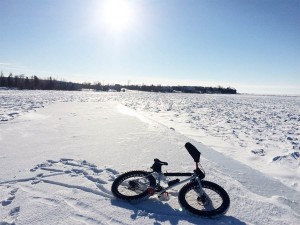 But guess what? I can’t bloody ride it at all. It’s completely bizarre. The surface looks compacted, and it is. But as soon as I apply torque the back tire cuts into the snow and drops down about an inch and both front and back start sliding around. I’m thinking at first that it’s something about my technique, but no matter what I try I can’t keep the bike moving forwards for more than 10 or 12 feet.
But guess what? I can’t bloody ride it at all. It’s completely bizarre. The surface looks compacted, and it is. But as soon as I apply torque the back tire cuts into the snow and drops down about an inch and both front and back start sliding around. I’m thinking at first that it’s something about my technique, but no matter what I try I can’t keep the bike moving forwards for more than 10 or 12 feet.
Restarting a stalled bike in the snow is a pain in the arse, as anyone who has tried it knows. But having to restart every 10 feet quickly becomes nonsensical. After 30/40 minutes I look back down the trail and realize that I could’ve easily covered more distance on foot. Now it really doesn’t make any sense.
So I change plans for the second time and decide to push the bike through the woods and get back on to the internal park roads. I know that much of the road system will be unplowed but I hope I can pedal through it, south towards the car, and pick up some plowed sections as I get closer to the Ranger’s station adjacent the parking lot. It’s a plan, but as it turns out, it’s a piss-poor one.
I hit the road and sure enough there’s 6 inches of virgin snow, the same powdery stuff that I encountered at the start of the ride. It’s deeper here as there’s no tree cover and there’s also quite a lot of drifting where the wind has blown across the open terrain.
And sure enough it’s virtually unrideable, I persevere the best way I can.
As it turns out I was foolish. I should’ve tracked back to the Highway and headed back to the car, it would’ve taken less than an hour at this point. But like the dumbfuck that I am, I decided to traverse the internal park road system and hope that soon I’d encounter roads which had been plowed.
The drill was basically this – ride 10 feet, slide out, stall, restart, rinse and repeat. I probably pushed the bike for 70% of the distance at this point – up hill, down dale, through the snow we go.
I didn’t see another soul out there and the only tracks I saw were animal tracks. In parts the snow had drifted and it would come up to my knees. My boots were full, my hands frozen, my feet….they were still back at the car.
I stopped occasionally to break icicles from my beard and once or twice to pee, but stopping for more than a minute I could feel my body temp fall rapidly. My clothes were wet from sweat and I had to keep moving to prevent hypothermia.
Two hours later I hit the lower road at Tennison Bay and saw the first set of vehicle tracks in the snow. I was elated. I knew I still had a few miles to go, and the light was fading rapidly, but riding in the vehicle tracks I ought to be able to make quick progress. Wrong.
After struggling for 30 minutes trying to keep the bike moving forwards in the vehicle tracks I switched back to the center path between the two tire tracks, and the 6-8″ virgin snow. It was ever so slightly easier.
I should say at this point that any riding I’d been able to do had been either in the granny gear or one up. Of course I’d experimented with using higher gears, but it didn’t help. But in any case, mostly I was walking and pushing, heaving and sweating, groaning and moaning, and swearing….a lot of swearing. It was childbirth out there. I was fucking exhausted and dehydrated. Yeah, my bottle of water had frozen up thirty minutes into the ride. I was only supposed to be out for ninety minutes or so.
At around 5pm the vehicle tracks came to a halt and beyond it the road was plowed. Finally.
I shifted up 3 or 4 cogs and gained a second wind as the finish line was in sight. It was now almost pitch black. To my right was the Bay of Green Bay and I could see the lights from the streets of Fish Creek across the bluff and body of water. The Bay was frozen over and clouds of snow dust were being whipped up by the brisk wind. On the horizon an orange glow was still evident though the sun had fully set. A narrow line of iridescent color glowed on the horizon, contrasting starkly between the blackness of the sky and the whiteness of the frozen bay. It was a beautiful scene, surreal by any standards. I thought of stopping to take a photo but knew my iPhone didn’t work at temps below 25F. It was long since frozen, as were my hands.
It was 5.30pm when I arrived back at the car. A 4.5 hour “ride” into a snowy hell, and back.
I don’t need to spell out the lessons learned. Obviously not all snow is created equal and fat tires ain’t gonna handle everything that you try and throw at them. I’m surprised however at the extent of their limitations when it comes to snow. This is the substrate for which they were designed, after all.
It hasn’t changed my opinion of fat bikes or of winter riding. They’re still awesome bikes, and winter riding can be a lot of fun, so long as you’re flexible enough to adapt to the varied conditions and not too stubborn to throw the towel in when the conditions are unrideable.
If you’ve ridden a Fattie in snow yourself, and you’ve never had these experiences, then trust me, it’s because you’ve been fortunate and the conditions have been favorable. Here’s a Yoot vid where you can see exactly what I’m talking about, and then some.
FatManBiking
January 2015
PS – during the ride as I was gradually becoming more and more underwhelmed at my predicament, I was having serious thoughts about throwing the towel in on any winter riding. There’s a high degree of risk involved in winter riding, particularly when riding solo on remote trails. Had I fallen, or twisted an ankle or knee, I may never have made it out of the park alive. I was ill equipped for this expedition and it had me thinking that the whole thing was folly. But the thoughts didn’t stick around for long, so no permanent damage done to my moral.
The following day I was a physical wreck, but decided a nice ‘cool-down’ ride was in order. I stuck to the sloppy side roads and cruised on down to Murphy’s Park, which is also on the Bay of Green Bay, just a few miles from my home.
Here’s a picture from Saturday’s ride.


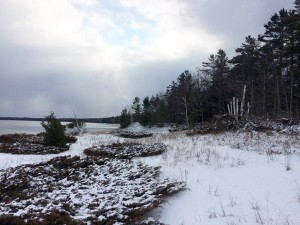
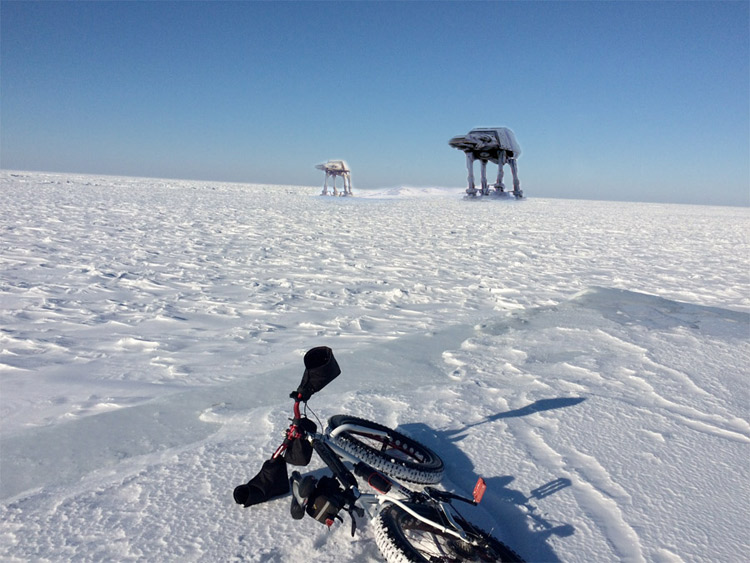
Excellent report! That’s why I watched about 65 Fat bike videos trying to make up my mind about them. On snow it was tits up about 40% of the time, which is better than a 29er’s 70-80% tits up rate, but when the Fat bike failed to deliver the goods, they really flippin’ failed because of the extra weight and the tire width actually becomes more of an impediment than a skinny tire.
I went off-road on 2-3 inches of medium-soft snow and it went great; now I’m waiting for a nearby snow machine trail to be groomed and get some compaction from use, otherwise I’d scrunch down and lose traction just as you described.
Find some sandy beaches come Spring-Summer; the light bulb went off over my head every time I saw a Fat bike beach video, the best one being on the shores of Lake Michigan!
May the force be with you (that’s very funny)!
Hey Richard,
Yeah, beach riding is a lot of fun. I rode the dunes on Lake MI just south of Two Rivers a few weeks ago and it was awesome….the bike worked really well…tons of traction on the steep dunes.
I’m really twitching over pulling the trigger on something much lighter. The Charge Cooker weighs almost 40lbs, perhaps even more with the full winter kit. It would be great to get the weight down to perhaps 25 or so. I really like the looks of the Salsa Beargrease. But it’s a lot of moolah and I’d take a hit on mine as a trade-in.
Maybe I should just lose some weight!
Enjoy your winter riding!
Yup. Thats what I tell everyone who asks what its like to ride in the snow:
“Depends on the snow” and “it depends on whats under the snow”
“Is it fun?”
“Sometimes its so much fun you hope summer never returns. Sometimes you feel like a complete jackass and wonder ” wtf was I thinking?”.”
Great article, by the way. Nailed it.
Thanks Eddy!
So, is there really a niche for a fat bike or is it just a fad?
@SemperFi – I’d say it’s more than a niche. Remember the blue pill that people over 50 (who don’t bike) take to help them keep up, well that pill was actually created as cardiovascular medication, the pecker thing was a side-effect. We all know what happened once the side-effect was discovered.
Fat bikes are going a similar way (yes, they turn you on). They were designated as snow/beach bikes, but as it turns out they’re very capable as an all-terrain / all-season mountain bike. As the weight comes down people are ditching their FS MTB’s and riding fat bikes. They’re becoming popular on dry trails and even as long-haul touring machines when fitted out with a 29er wheel.
As more people come to realize that one bike can replace two or three, they’ll continue to evolve and gain popularity.
In fact I’d say that as a snow bike, their real talent and potential is wasted.
Lolz, “the dumb fuck that I am” Love your humility and tenacity 🙂
Great article! I live near the beach in NJ and often borrow a Fat from the shop and do a Sunday morning winter ride right on the sand once their is too much snow to ride our local trails.
So My dilemma is coming off a 29er SS as my only current Rig, do I go Fat or go Semi Fat (Spesh 6Fattie, etc). My answer seems to be both but for now I may skip Fat for one more season and go Semi Fat with a Specialized Fuse. I can run a number of wheels/Tires on it mostly 3″” and down.
I found your article really wondering how far can you take the Fat in the snow. Stage 3 winter is clearly a train wreck and almost no bike is out there other than a true beach ride which does exist for us down here. Regular 29ers crap out after Stage 1. I wonder what will happen to this newer wheel I’m gong to try but only able afford one new rig its 6fattie for me. And hey, this is a big deal. I have been Single Speed only for 3 seasons now, I think I have earned a few gears regardless of Wheel/Tire size.
Thanks for a hilarious read!
I’ve had a 29er with studded Nokias for the last 4 years on trails where I live, fresh snow sucks but when the thaw melt starts the tires work great.
I have fat tire bike with Husker Due 45’s for summer riding. I’d like to get winter tires and Dilleringer’s 45’s look like a good option but $$$ especially in studded version, maybe non studded a better option. I know fat bike won’t be great in all conditions as is the 29er. I’ve read the wider the rim the better but if I go past 82 mm I might loose the two easiest gears on chainring. I have a Boo fat tire which handles amazingly. I weigh 155 lbs and have been playing with pressures during the summer and have found 6lb in back and 5 1/2lb in front stops much of the bouncing around, of course I’m tubeless. Any suggestions on winter rim/tire set-ups. I also ride alone but have my dogs with me, maybe Lassie will save me one day.Thank you
Phil
Hey Phil,
Going with a wider (than 82mm) rim will give you a little benefit on inflated tire width, but really not much. Can your bike handle the 4.8″ tires, stock, or are you limited to 4″?
If you’re limited to 4″ and shopping on a budget then I found the On One Floater tires to work well in snow, and even with the cost of shipping from the UK they come in cheaper than offerings from Surly and 45NRTH.
You could also look out for a pair of used Dillinger 4’s and if there’s enough tread left on the tire, stud them yourself.
Also, you’ll want to go way lower on tire pressures to get the most benefit from the tires in snow. I run mine at around 2psi and I’m heavier than you by a fair amount. You do get used to that bounce/pogo effect after a while, just try shifting up to a higher gear and work at a smooth cyclical pedal stroke.
Even with everything optimized, there’s going to be some snow conditions where you still can’t get any traction.
FMB
Here’s a chart that shows rim width impact on tire width (45NRTH Tires only) http://45nrth.com/files/pages/13193_45N_Tire_Geo_Update_V3.pdf
I just tested the new Raleigh Rumson with 4.9in tires in about 8in of fresh powder and it didn’t do too well. Really good ride and good traction on the packed down snow and ice, but it just wanted to float over everything, including the deep snow and didn’t get any traction. That same day I rode around on my hybrid road bike with 700×40 Nokian Hakkapeliittas, the tire just sank through to the ground and I had plenty of traction to keep going, even with the entire front chainrings buried. The problem I have with the road bike is that once things start getting packed down and frozen, the bike jumps all over with any little ruts, footprints, or grooves, and even with studded tires it wants to slip around for traction; which is why I was considering a fat bike as a winter commuter. Still thinking about taking the plunge because it was super fun, and anytime it did slide out it was so controllable I didn’t mind at all. Living in Minnesota we get a lot of snow, and I commute all year so I’m pretty sure I’ll get good use out of it.
This was a great article! I just tried to ride in about 6 inches of powder. I am new to my fat bike, and felt totally demoralized when I could not really sustain forward motion. Especially when I saw a guy pass my with a lot of effort, but seemingly no issues like I was having. I totally see it depends on the snow and know that it will be great fun when the fluffy powder is packed down. Some different tires may help too. I’m not going to stop trying. Thanks for writing.
I loved your article and video. I was laughing at your witty writing and watching the video made me chuckle! Thanks! And yes, I own a fat bike but haven’t tried any winter riding. I love my bike but this article sure opened my eyes.